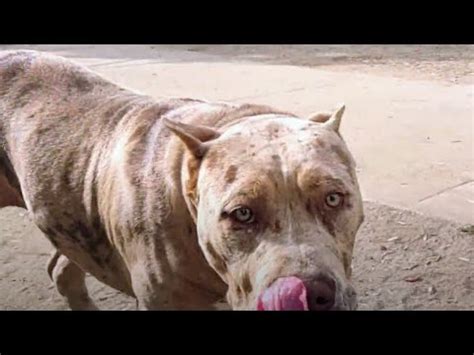
A Florida dog owner was surprised after his Bully breed dog, named Bonnie, returned from a grooming appointment sporting dramatically altered eyebrows, giving her an unexpectedly expressive and human-like appearance. The change, achieved through shaving the fur above Bonnie’s eyes, prompted a viral reaction online, with many finding the dog’s new look amusing and commenting on her seemingly judgmental expression.
Robert, Bonnie’s owner, expressed his initial shock at the transformation. “I didn’t know what to think,” he admitted, highlighting that the groomer had taken a liberty he didn’t expect. The incident has sparked a debate about grooming styles and owner-groomer communication, showcasing how a simple aesthetic choice can lead to widespread attention.
Unexpected Transformation Leads to Internet Fame
Bonnie, a Bully breed dog, became an overnight sensation after her owner, Robert, from Florida, shared images of her post-grooming transformation online. The dramatic change involved the groomer shaving the fur above Bonnie’s eyes, creating pronounced eyebrows that gave her a remarkably human-like and expressive face. Robert, who was initially taken aback by the new look, quickly saw the humor in the situation and decided to share Bonnie’s “furry new look” with the world.
The response was immediate and overwhelming. Photos of Bonnie’s brow transformation quickly went viral across various social media platforms. Users were captivated by the dog’s seemingly judgmental and comical expression, leading to countless shares, comments, and memes. Bonnie’s unique appearance resonated with a wide audience, showcasing the power of the internet to turn ordinary moments into viral sensations.
Owner’s Reaction and Groomer’s Perspective
Robert’s initial reaction to Bonnie’s new look was a mix of surprise and amusement. “I didn’t know what to think,” he confessed, acknowledging that he had not specifically requested the eyebrow modification. Despite his initial shock, Robert took the incident in stride, recognizing the humor in the situation. He emphasized that while the transformation was unexpected, he ultimately found it entertaining and appreciated the joy it brought to others online.
The groomer’s perspective on the situation remains largely unknown, as Robert did not publicly disclose the groomer’s name or specific reasoning behind the eyebrow alteration. However, it’s common practice for groomers to make aesthetic decisions based on their professional judgment, breed standards, and client preferences. In some cases, groomers may believe that shaping the fur around the eyes can enhance the dog’s appearance or improve their vision. While communication between pet owners and groomers is crucial to avoid misunderstandings, unforeseen aesthetic choices can sometimes occur, leading to unexpected outcomes like Bonnie’s eyebrow transformation.
Debate on Grooming Standards and Owner Communication
Bonnie’s story has sparked a broader conversation about grooming standards, owner expectations, and the importance of clear communication between pet owners and groomers. While some individuals found Bonnie’s new look amusing and harmless, others expressed concern about the potential impact of drastic grooming alterations on a dog’s well-being and natural appearance.
Some critics argued that shaving a dog’s eyebrows could potentially irritate their skin or disrupt their natural ability to protect their eyes from sunlight and debris. Additionally, some raised questions about whether the groomer had obtained informed consent from Robert before proceeding with the eyebrow modification.
On the other hand, many people defended the groomer’s actions, arguing that it was a harmless aesthetic choice that did not cause any physical harm to Bonnie. They emphasized that grooming is often a matter of personal preference and that pet owners have the right to choose how their animals are styled, as long as it doesn’t compromise their health or safety.
The incident serves as a reminder of the importance of establishing clear communication channels between pet owners and groomers. Pet owners should clearly communicate their specific preferences and expectations to avoid misunderstandings or unwanted alterations. Similarly, groomers should take the time to understand their clients’ wishes and provide professional guidance to ensure that grooming decisions align with the pet’s well-being and the owner’s aesthetic preferences.
Impact on Bully Breed Image and Stereotypes
Bonnie’s viral transformation also raises questions about the broader perception and stereotypes surrounding Bully breed dogs. Bully breeds, such as American Bullies, Pit Bull Terriers, and Staffordshire Bull Terriers, are often subjected to negative stereotypes and misconceptions due to their muscular appearance and historical association with dogfighting. These stereotypes can lead to discrimination, breed-specific legislation, and difficulties for Bully breed owners in finding housing and insurance.
Bonnie’s story offers an opportunity to challenge these negative stereotypes and showcase the softer, more humorous side of Bully breeds. Her comical expression and viral fame can help to humanize these dogs and dispel the myth that they are inherently aggressive or dangerous. By highlighting Bonnie’s individual personality and unique appearance, her story can contribute to a more nuanced and positive perception of Bully breeds in general.
The Power of Viral Content and Online Communities
Bonnie’s story exemplifies the power of viral content and online communities to transform ordinary individuals and animals into overnight sensations. The internet’s ability to rapidly disseminate information and connect people from all over the world has created a unique environment where unexpected moments can capture the attention of millions.
In Bonnie’s case, her humorous appearance resonated with a wide audience, leading to a rapid spread of her photos across various social media platforms. The viral attention generated by Bonnie’s transformation not only brought joy and laughter to countless individuals but also created a sense of community among those who shared and commented on her photos.
The internet has become a powerful tool for sharing stories, connecting with others, and celebrating the unique qualities that make individuals and animals special. Bonnie’s viral fame serves as a reminder of the power of online communities to create meaningful connections and spread positivity in an increasingly digital world.
Broader Context of Pet Grooming Trends
The incident with Bonnie also fits into a broader context of evolving pet grooming trends. Pet grooming has become increasingly sophisticated, with owners seeking creative and personalized styles for their beloved animals. From elaborate haircuts and colorful dyes to intricate nail art and spa treatments, pet grooming has transformed from a basic hygiene practice into a form of artistic expression.
The rise of pet grooming trends reflects the increasing role that pets play in modern families. Pets are often considered members of the family, and owners are willing to invest significant time and resources in ensuring their well-being and happiness. Grooming is seen as a way to pamper pets, enhance their appearance, and strengthen the bond between owner and animal.
However, the pursuit of trendy grooming styles can sometimes lead to ethical concerns. It’s important to ensure that grooming practices are safe, humane, and respectful of the animal’s natural behavior and appearance. Pet owners should prioritize their animal’s comfort and well-being above all else, and groomers should be mindful of the potential risks associated with certain procedures.
Expert Opinions on Dog Grooming Practices
Veterinarians and professional dog groomers emphasize the importance of responsible and ethical grooming practices. They caution against subjecting dogs to extreme or unnecessary grooming procedures that could potentially harm their physical or emotional well-being.
“Grooming should always be a positive experience for the dog,” says Dr. Emily Carter, a veterinarian specializing in canine care. “It’s important to choose a groomer who is experienced, gentle, and knowledgeable about dog behavior. Avoid groomers who use excessive force or pressure, or who recommend procedures that could cause pain or discomfort.”
Professional groomers also stress the importance of open communication with pet owners. “Before starting any grooming procedure, it’s essential to discuss the owner’s preferences and expectations,” says Sarah Johnson, a certified dog groomer. “We need to understand what the owner wants and explain the potential risks and benefits of different grooming options. It’s also crucial to be honest about what is realistically achievable, given the dog’s breed, coat type, and temperament.”
Experts recommend that pet owners research different grooming styles and techniques before making any decisions. They should also ask their veterinarian for recommendations on reputable groomers in their area. By working together, pet owners, veterinarians, and groomers can ensure that grooming practices are safe, ethical, and beneficial for the dog’s overall health and well-being.
Legal and Ethical Considerations in Pet Grooming
In some jurisdictions, there are specific laws and regulations governing pet grooming practices. These laws may address issues such as licensing requirements for groomers, standards for sanitation and hygiene, and restrictions on certain grooming procedures.
For example, some states have laws prohibiting the use of certain types of dyes or chemicals on animals. Other states may have regulations requiring groomers to obtain informed consent from pet owners before performing certain procedures.
In addition to legal considerations, there are also ethical considerations that should guide pet grooming practices. Groomers have a responsibility to treat animals with respect and compassion, and to avoid causing them unnecessary pain or suffering. They should also be transparent with pet owners about the potential risks and benefits of different grooming options.
Ethical groomers prioritize the animal’s well-being above all else, and they are willing to decline grooming requests that could potentially harm the animal. They also educate pet owners about responsible grooming practices and encourage them to make informed decisions about their pet’s care.
Long-Term Implications for Bonnie and Her Owner
The long-term implications of Bonnie’s viral fame are still unfolding. While her story has undoubtedly brought joy and laughter to many, it remains to be seen whether it will have any lasting impact on her life or her owner’s.
It’s possible that Bonnie’s fame could lead to opportunities for endorsements or collaborations with pet-related businesses. She could also become an advocate for Bully breeds, helping to dispel negative stereotypes and promote responsible pet ownership.
However, it’s also important to be mindful of the potential downsides of fame. Excessive attention and scrutiny can be stressful for both animals and their owners. It’s crucial for Robert to protect Bonnie’s privacy and well-being, and to ensure that her newfound fame doesn’t compromise her quality of life.
Ultimately, Bonnie’s story serves as a reminder of the unpredictable nature of viral content and the importance of using online platforms responsibly. While fame can be fleeting, the memories and connections created through shared experiences can last a lifetime.
Conclusion
Bonnie’s unexpected eyebrow transformation serves as a lighthearted reminder of the importance of clear communication, responsible grooming practices, and the power of the internet to connect people through shared laughter and amusement. While her new look sparked a debate about grooming standards and owner expectations, it also provided an opportunity to challenge negative stereotypes surrounding Bully breeds and celebrate the unique qualities that make each animal special. As Bonnie’s story continues to unfold, it’s important to prioritize her well-being and ensure that her newfound fame doesn’t compromise her quality of life. The incident also underscores the need for pet owners, groomers, and veterinarians to work together to ensure that grooming practices are safe, ethical, and beneficial for the animal’s overall health and happiness.
Frequently Asked Questions (FAQ)
-
What exactly happened to Bonnie the dog?
Bonnie, a Bully breed dog, had her eyebrows dramatically altered during a grooming appointment. The groomer shaved the fur above her eyes, creating prominent eyebrows that gave her a very expressive and human-like appearance, much to the surprise of her owner, Robert.
-
How did Bonnie’s owner react to her new look?
Robert, Bonnie’s owner, was initially shocked but then found the situation humorous. He stated he “didn’t know what to think” at first but ultimately embraced the change and shared photos of Bonnie’s new look online, leading to viral fame.
-
What kind of dog is Bonnie?
Bonnie is a Bully breed dog. The article does not specify the exact breed, but it broadly classifies her within the Bully breed category, which includes breeds like American Bullies, Pit Bull Terriers, and Staffordshire Bull Terriers.
-
Why did the groomer shave Bonnie’s eyebrows?
The exact reason for the groomer shaving Bonnie’s eyebrows is not explicitly stated in the article. However, groomers often make aesthetic decisions based on their professional judgment, breed standards, and client preferences. It’s possible the groomer thought it would enhance Bonnie’s appearance.
-
What is the significance of this story going viral?
The story went viral because of the unexpected and comical nature of Bonnie’s transformation. Her human-like eyebrows and seemingly judgmental expression resonated with many people online, highlighting the power of the internet to turn ordinary moments into viral sensations and sparking conversations about pet grooming and breed stereotypes.
-
What steps can pet owners take to avoid similar grooming surprises?
Pet owners can prevent unexpected grooming outcomes by thoroughly communicating their specific preferences and expectations to the groomer before the appointment. Providing clear instructions, showing pictures of desired styles, and discussing any concerns beforehand can help ensure that the grooming results align with the owner’s vision.
-
Are there any potential risks associated with shaving a dog’s eyebrows?
While shaving a dog’s eyebrows is generally considered a harmless aesthetic choice, some potential risks include skin irritation, discomfort, and reduced protection from sunlight and debris. It’s crucial to monitor the dog’s skin for any signs of irritation and to consult with a veterinarian if any concerns arise.
-
How does Bonnie’s story challenge stereotypes about Bully breeds?
Bonnie’s story challenges negative stereotypes about Bully breeds by showcasing their softer, more humorous side. Her comical expression and viral fame help to humanize these dogs and dispel the myth that they are inherently aggressive or dangerous. By highlighting Bonnie’s individual personality and unique appearance, her story contributes to a more nuanced and positive perception of Bully breeds in general.
-
What role do online communities play in spreading stories like Bonnie’s?
Online communities play a crucial role in spreading stories like Bonnie’s by providing platforms for sharing content, connecting with others, and creating a sense of collective amusement and engagement. Social media platforms, online forums, and meme-sharing websites facilitate the rapid dissemination of viral content, allowing unexpected moments to capture the attention of millions worldwide.
-
What ethical considerations should guide pet grooming practices?
Ethical pet grooming practices should prioritize the animal’s well-being, comfort, and safety above all else. Groomers should avoid subjecting animals to unnecessary stress, pain, or discomfort. They should also be transparent with pet owners about the potential risks and benefits of different grooming options and obtain informed consent before proceeding with any procedures. Responsible groomers are also aware of breed specific needs, and are capable of consulting with a vet if necessary.
-
What are some laws or regulations governing pet grooming practices?
Laws and regulations governing pet grooming practices vary by jurisdiction, but they may include licensing requirements for groomers, standards for sanitation and hygiene, and restrictions on certain grooming procedures. For example, some states have laws prohibiting the use of certain types of dyes or chemicals on animals, while others may require groomers to obtain informed consent before performing specific procedures.
-
What steps can Robert take to protect Bonnie’s privacy and well-being in light of her newfound fame?
Robert can protect Bonnie’s privacy and well-being by limiting her exposure to excessive attention and scrutiny. He can also carefully manage her social media presence, ensuring that any content shared online is respectful of her boundaries and doesn’t compromise her quality of life. It’s also important for Robert to prioritize Bonnie’s physical and emotional health by providing her with a safe and comfortable environment and consulting with a veterinarian if any concerns arise.
-
How can pet owners find reputable and ethical groomers in their area?
Pet owners can find reputable and ethical groomers by seeking recommendations from their veterinarian, asking friends and neighbors for referrals, and researching online reviews and ratings. It’s also important to visit the grooming facility in person to assess its cleanliness, safety, and the groomers’ interactions with the animals. Look for groomers who are certified, experienced, and knowledgeable about dog behavior and grooming techniques.
-
What are the long-term implications of Bonnie’s story for the pet grooming industry?
Bonnie’s story may raise awareness about the importance of clear communication between pet owners and groomers, as well as the potential for unexpected outcomes when aesthetic choices are not discussed beforehand. It may also prompt groomers to be more mindful of the potential impact of their work on the animals’ appearance and well-being, and to prioritize responsible and ethical grooming practices.
-
What is breed-specific legislation and how does it affect Bully breeds?
Breed-specific legislation (BSL) refers to laws and regulations that restrict or ban certain dog breeds based on their perceived dangerousness. Bully breeds, such as Pit Bull Terriers, are often targeted by BSL due to negative stereotypes and misconceptions. BSL can lead to restrictions on ownership, mandatory sterilization, increased insurance costs, and even the euthanasia of dogs based solely on their breed.
-
How can individuals advocate for responsible pet ownership and challenge negative stereotypes about Bully breeds?
Individuals can advocate for responsible pet ownership by educating themselves and others about responsible dog ownership practices, such as providing proper training, socialization, and veterinary care. They can also challenge negative stereotypes about Bully breeds by sharing positive stories and images of these dogs, advocating for breed-neutral legislation, and supporting organizations that promote responsible pet ownership and animal welfare.
-
What are the key takeaways from Bonnie’s story regarding the power of viral content?
The key takeaways from Bonnie’s story regarding the power of viral content include the ability of unexpected moments to capture the attention of millions, the role of online communities in spreading information and creating connections, and the importance of using online platforms responsibly. Viral content can be both entertaining and informative, but it’s crucial to be mindful of the potential impact on individuals and animals involved.
-
What resources are available for pet owners seeking information about responsible grooming practices?
Pet owners seeking information about responsible grooming practices can consult with their veterinarian, contact professional dog grooming organizations, and research online resources from reputable sources, such as veterinary associations and animal welfare organizations. These resources can provide valuable information about safe grooming techniques, breed-specific grooming needs, and ethical considerations in pet care.
-
How does social media contribute to evolving trends in pet grooming?
Social media platforms like Instagram, TikTok, and Pinterest play a significant role in driving and popularizing pet grooming trends. Groomers often showcase their creative work and unique styles on these platforms, inspiring pet owners to experiment with new looks for their animals. Viral challenges and trends can also contribute to the rapid spread of grooming styles, influencing pet owner preferences and driving demand for specific services.
-
What are the potential psychological effects of drastic grooming alterations on dogs?
Drastic grooming alterations can potentially have psychological effects on dogs, particularly if they involve significant changes to their appearance or require prolonged periods of restraint and handling. Some dogs may experience anxiety, stress, or fear during grooming procedures, especially if they are not properly socialized or accustomed to being handled. It’s important to ensure that grooming experiences are positive and stress-free for dogs, and to avoid procedures that could potentially cause them emotional distress.









